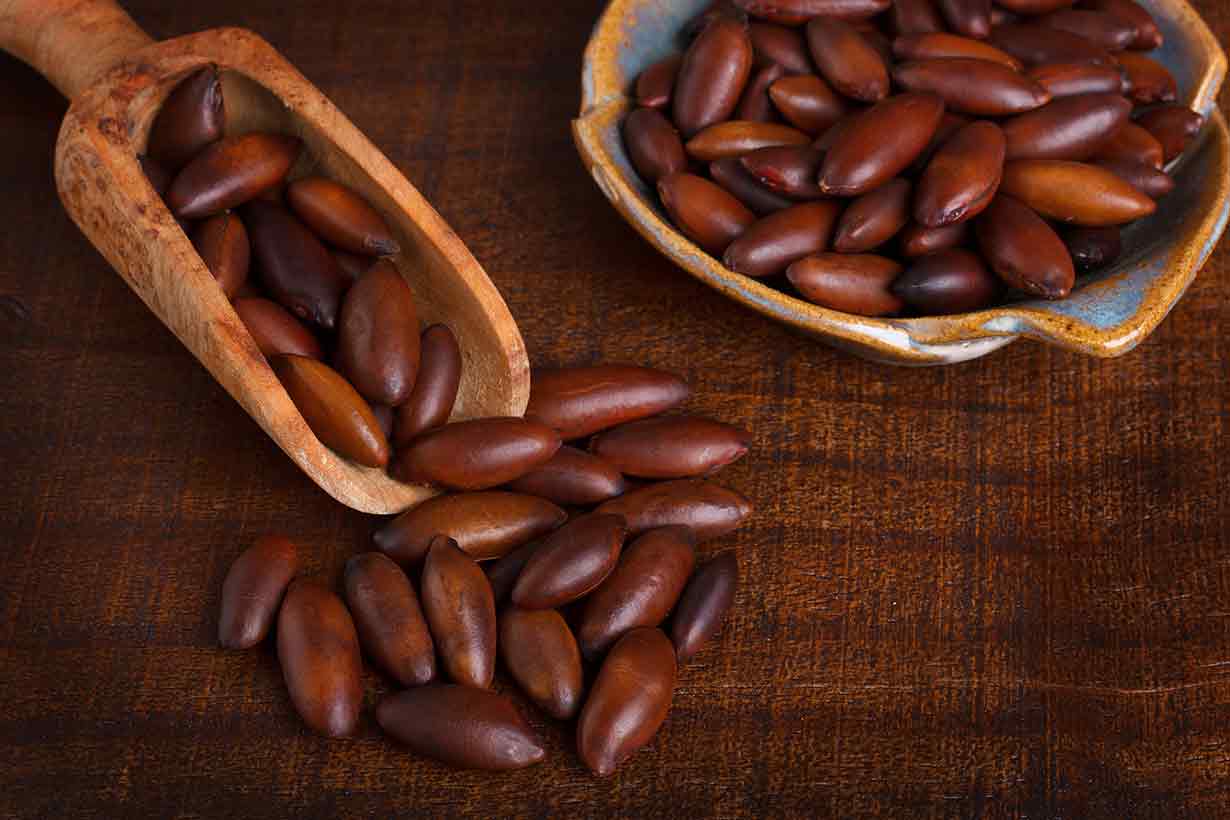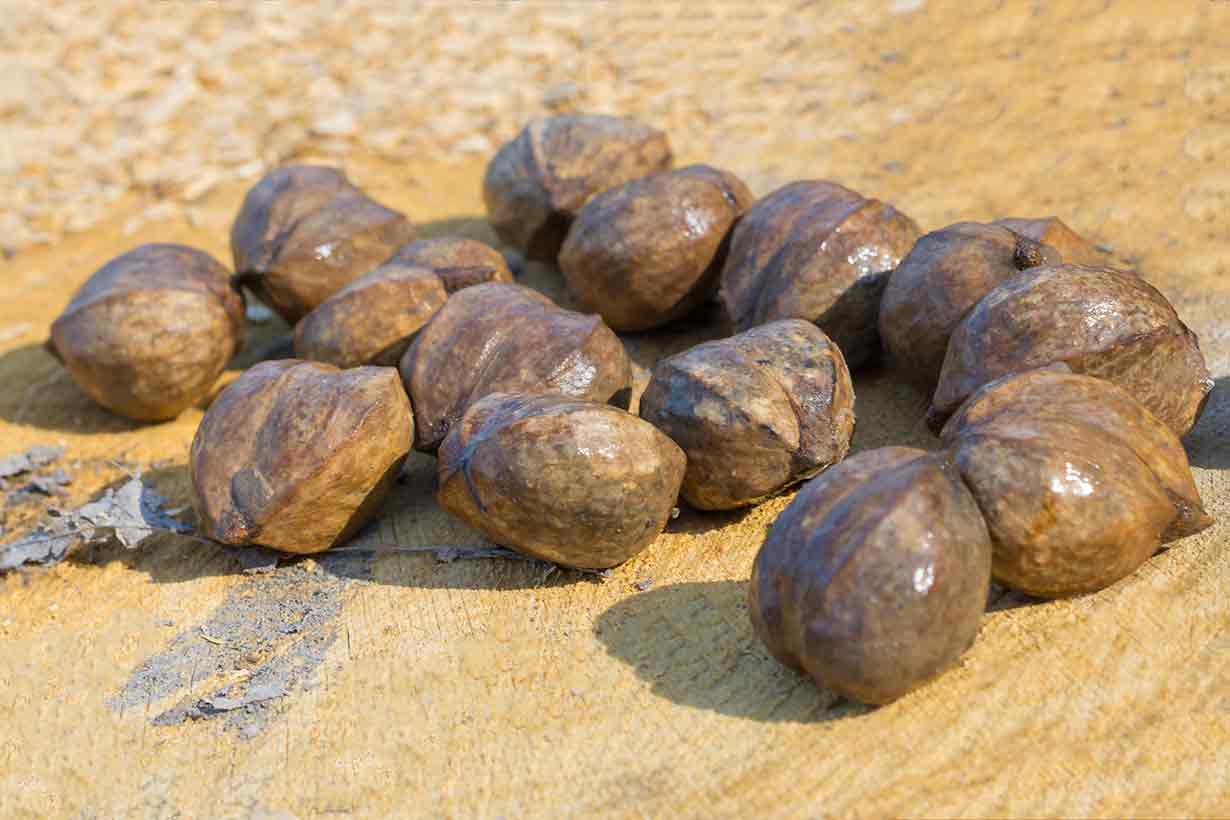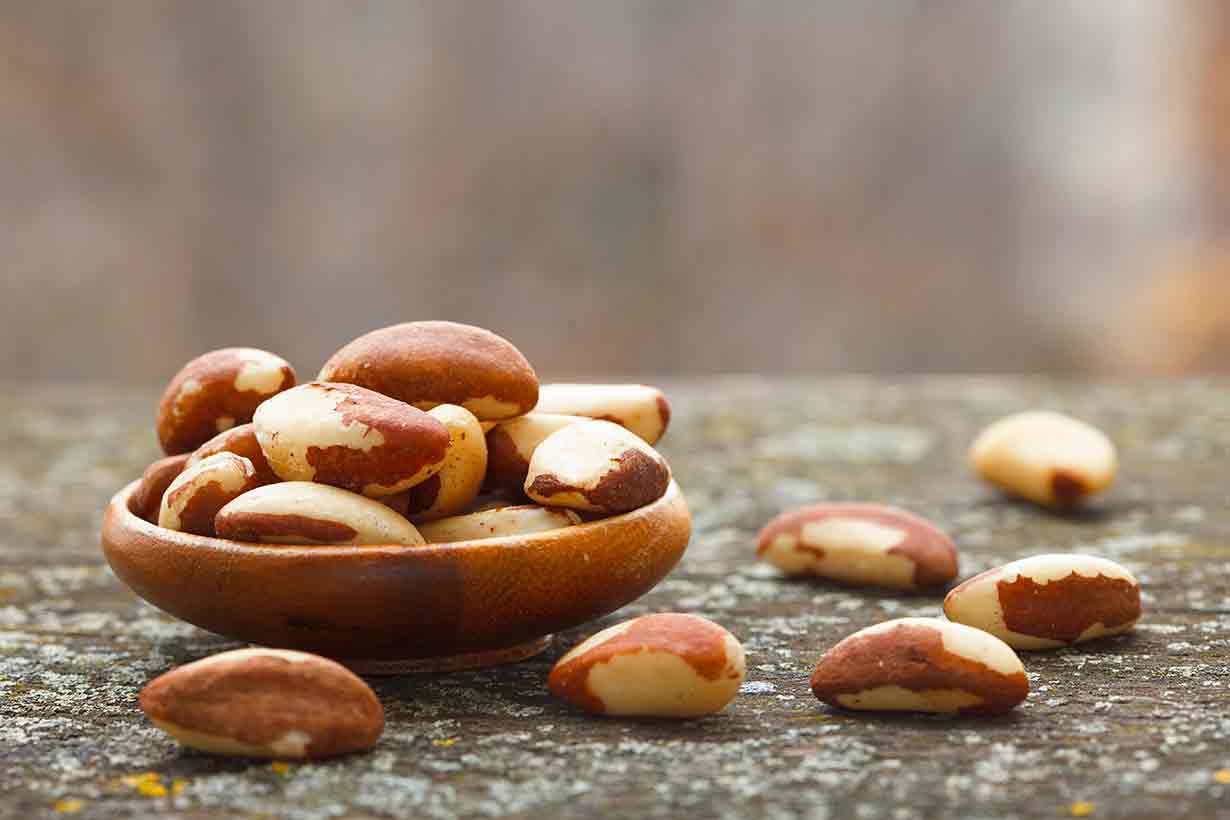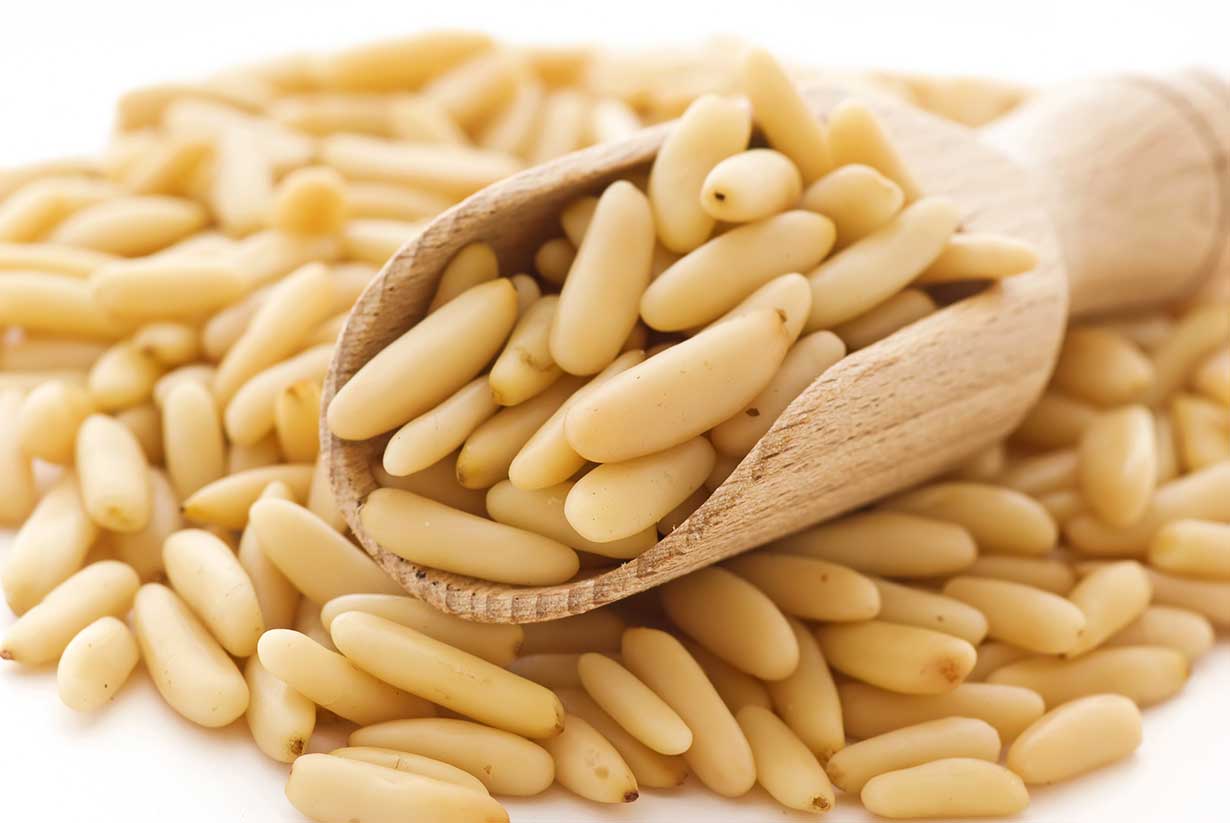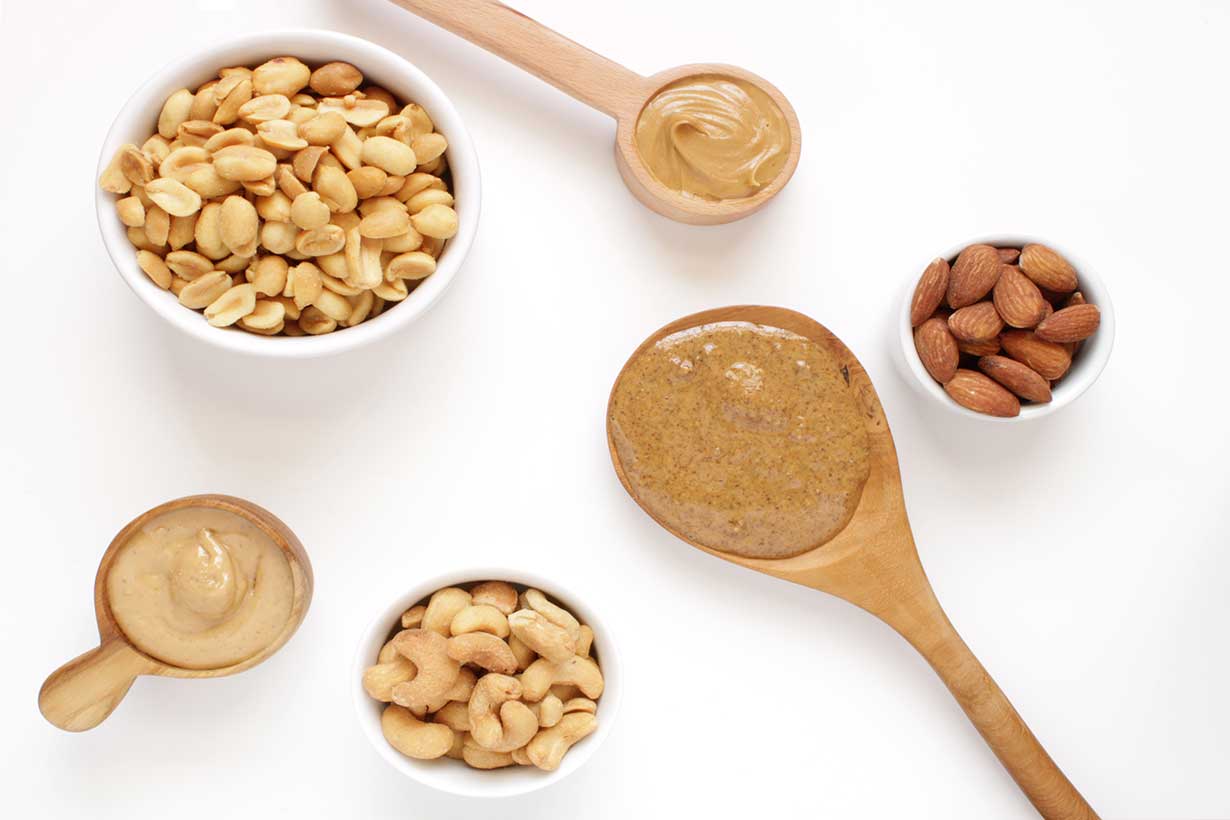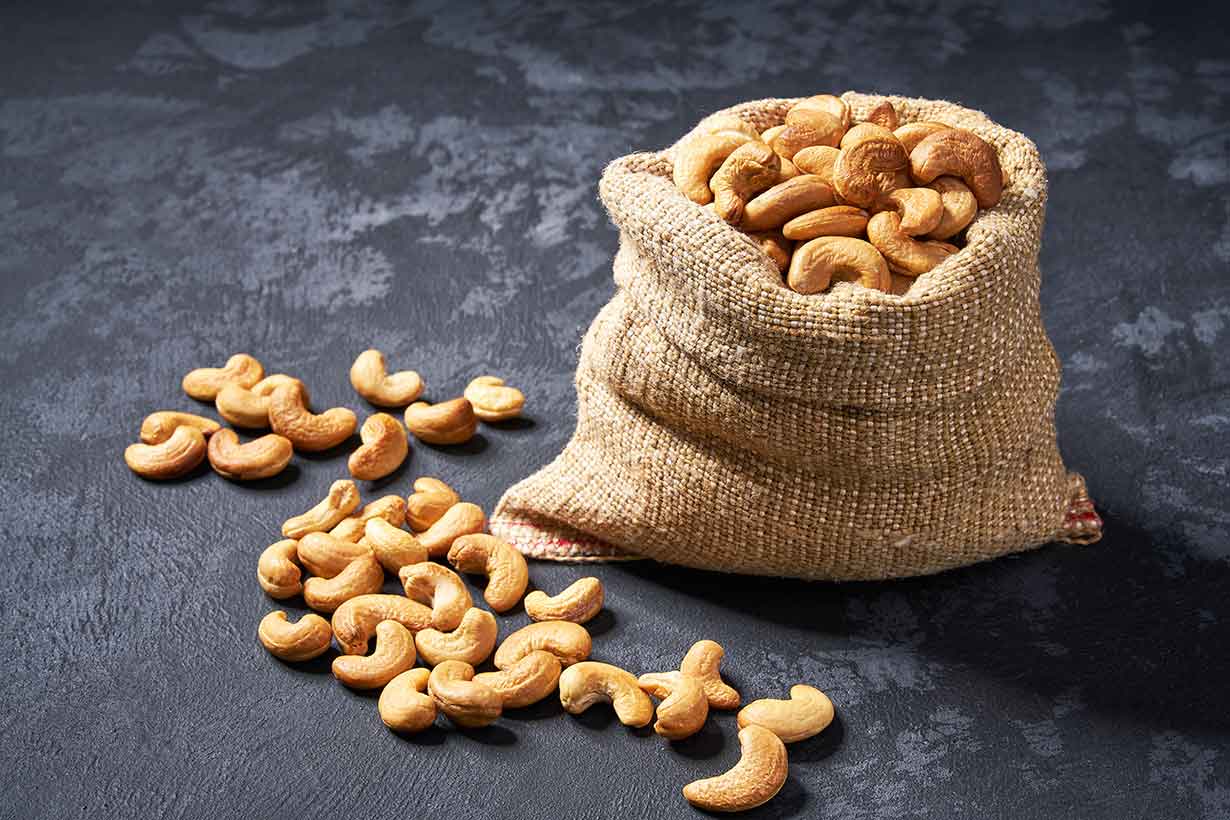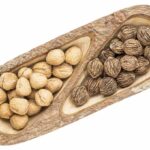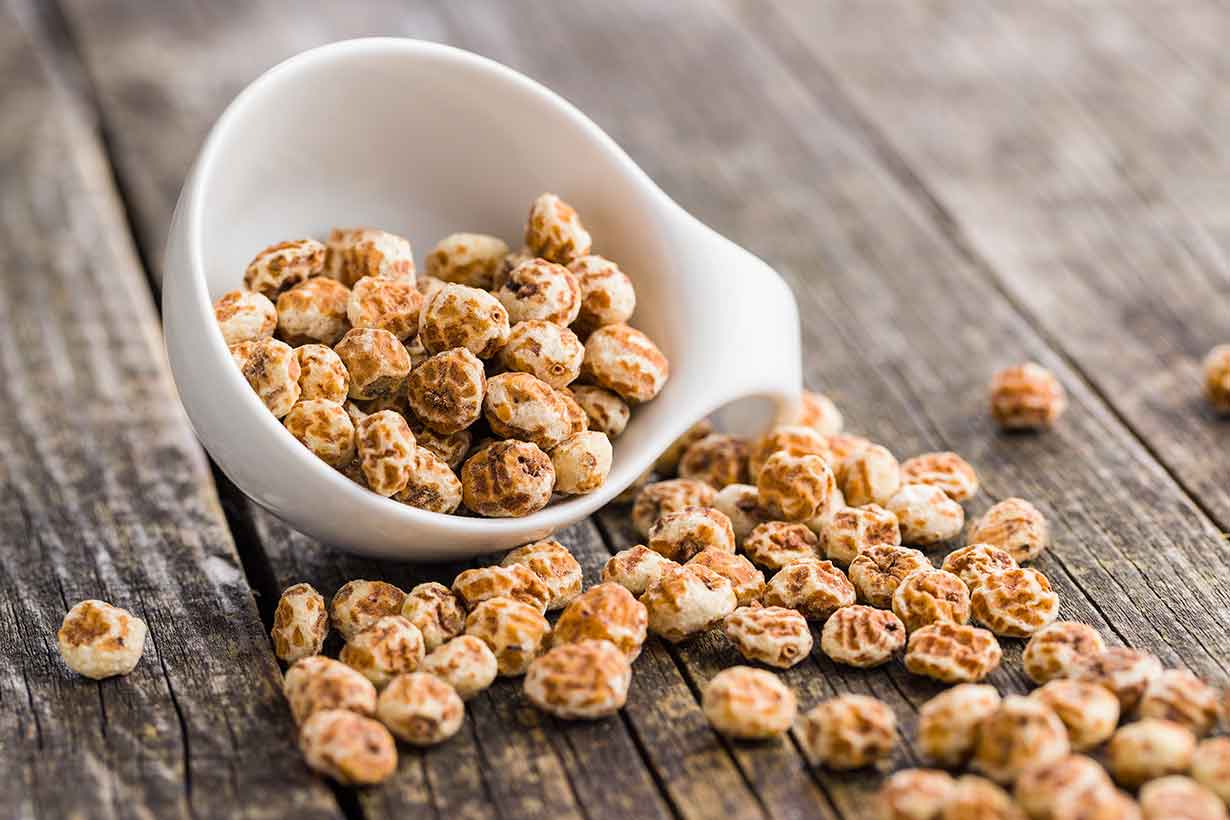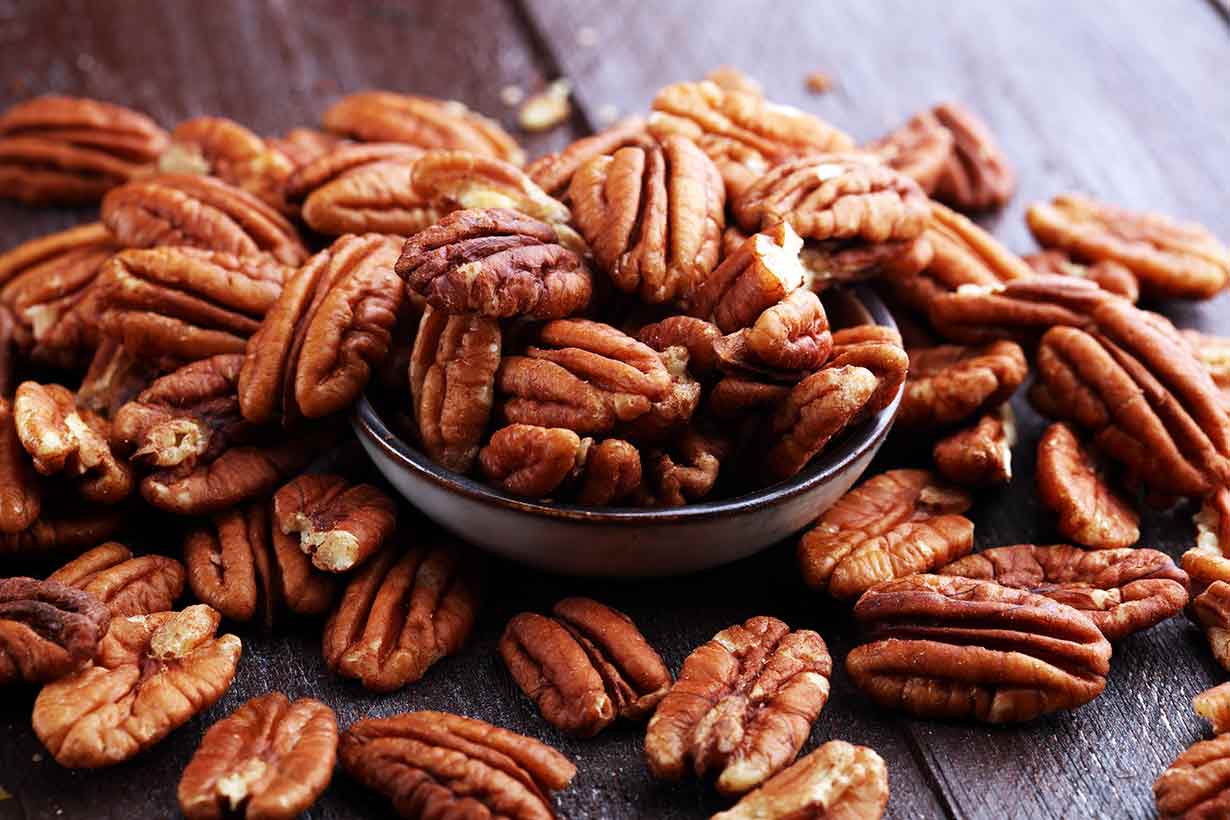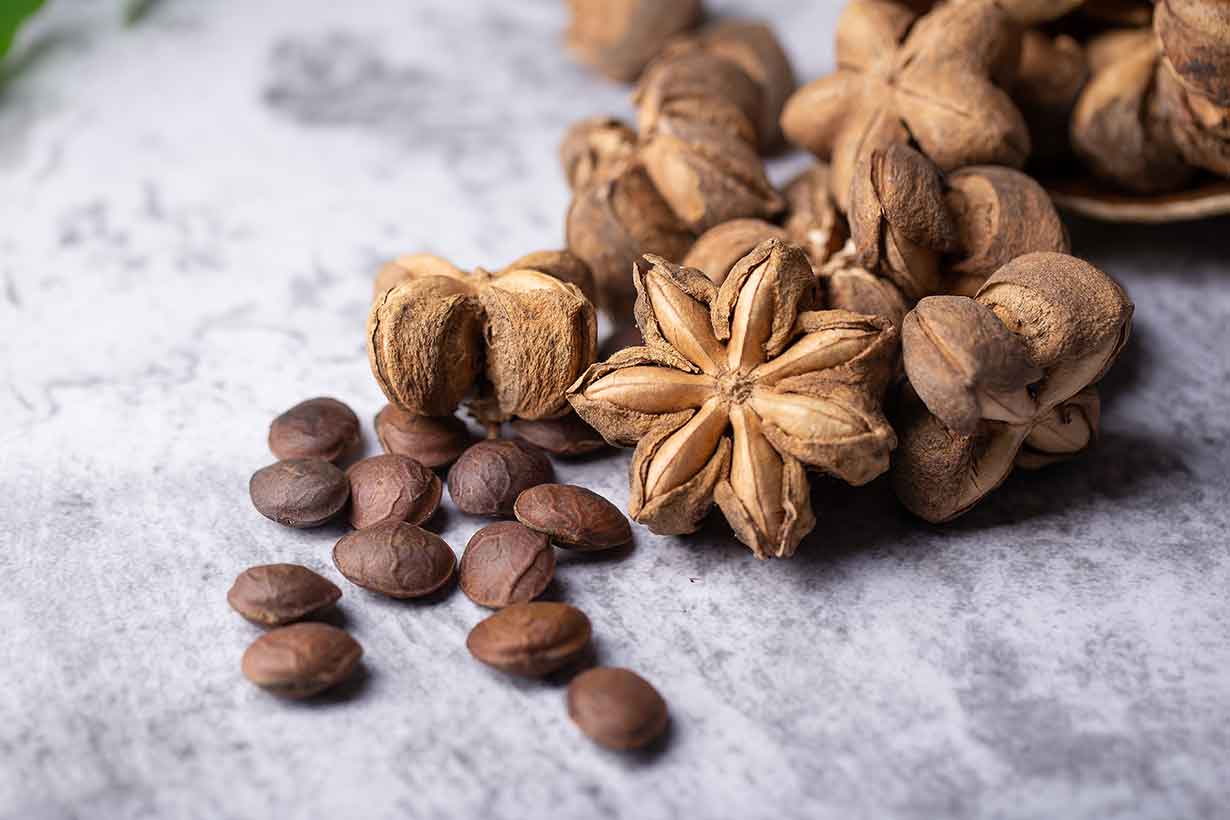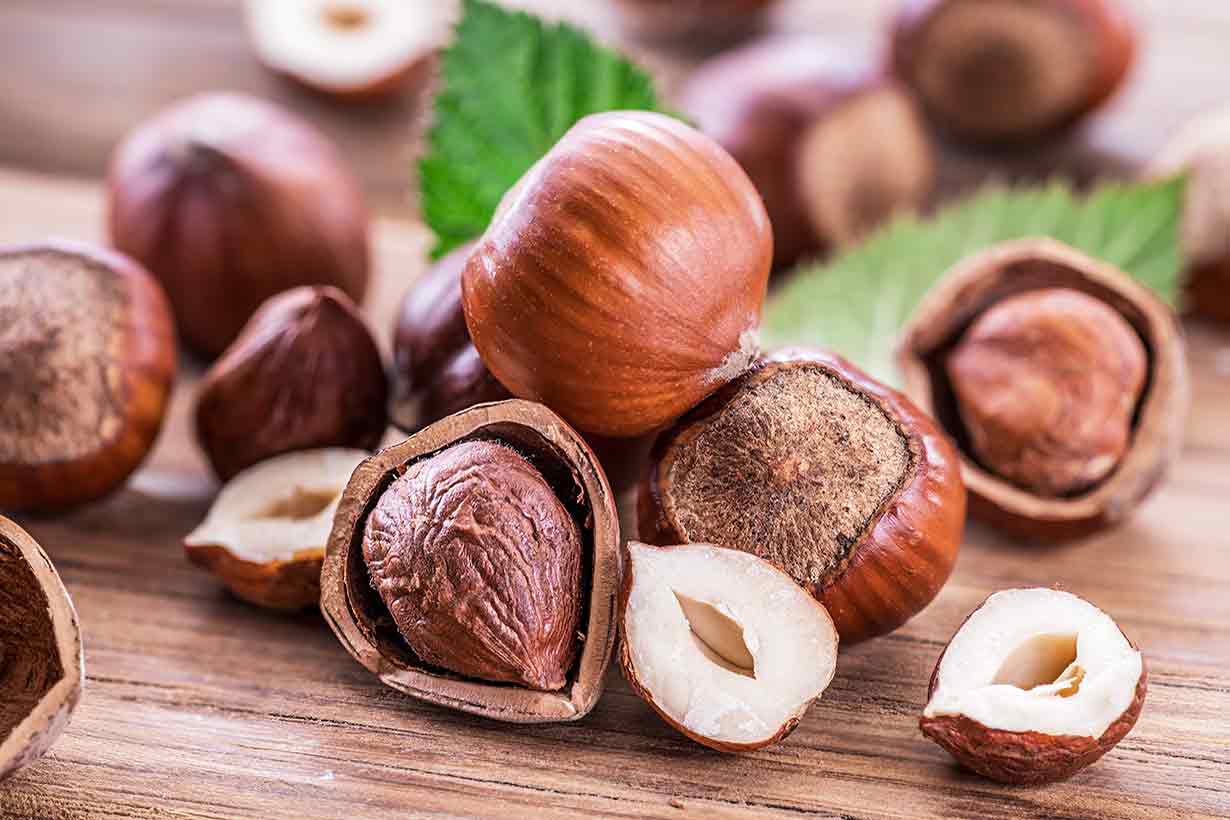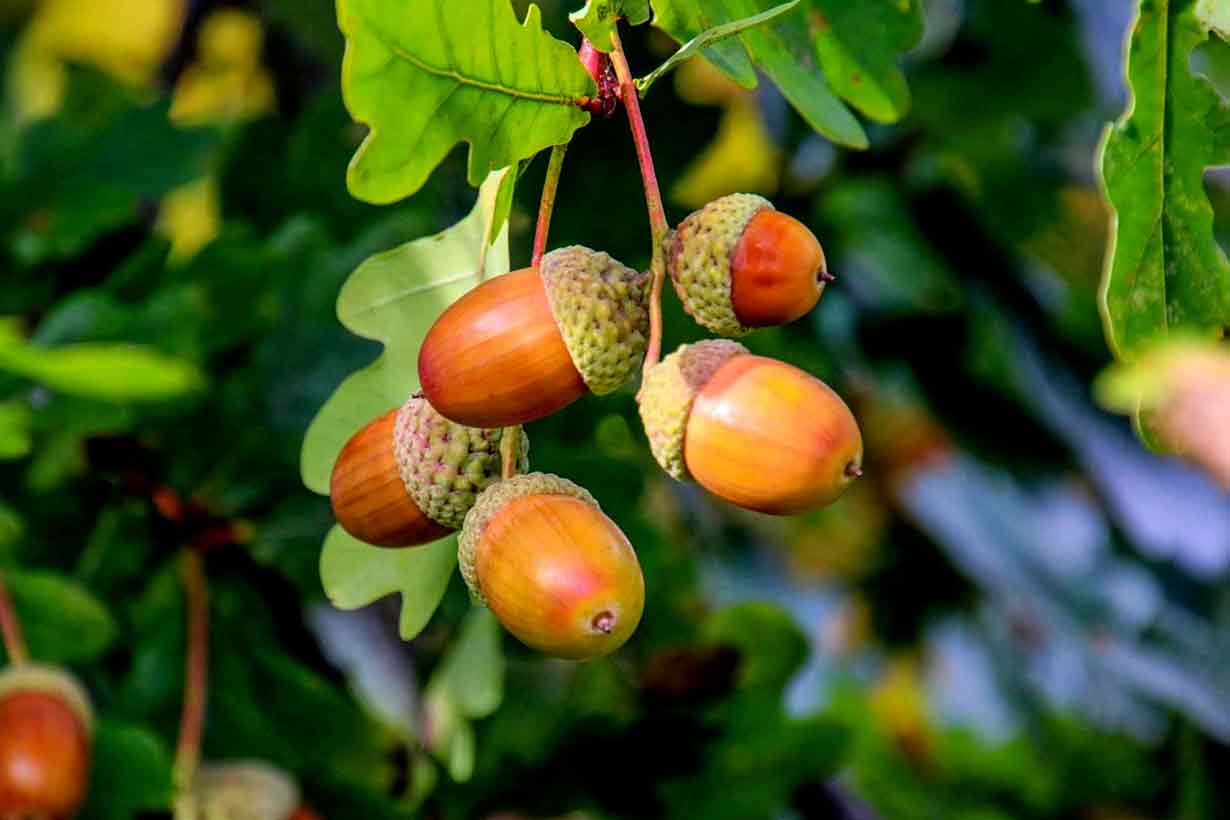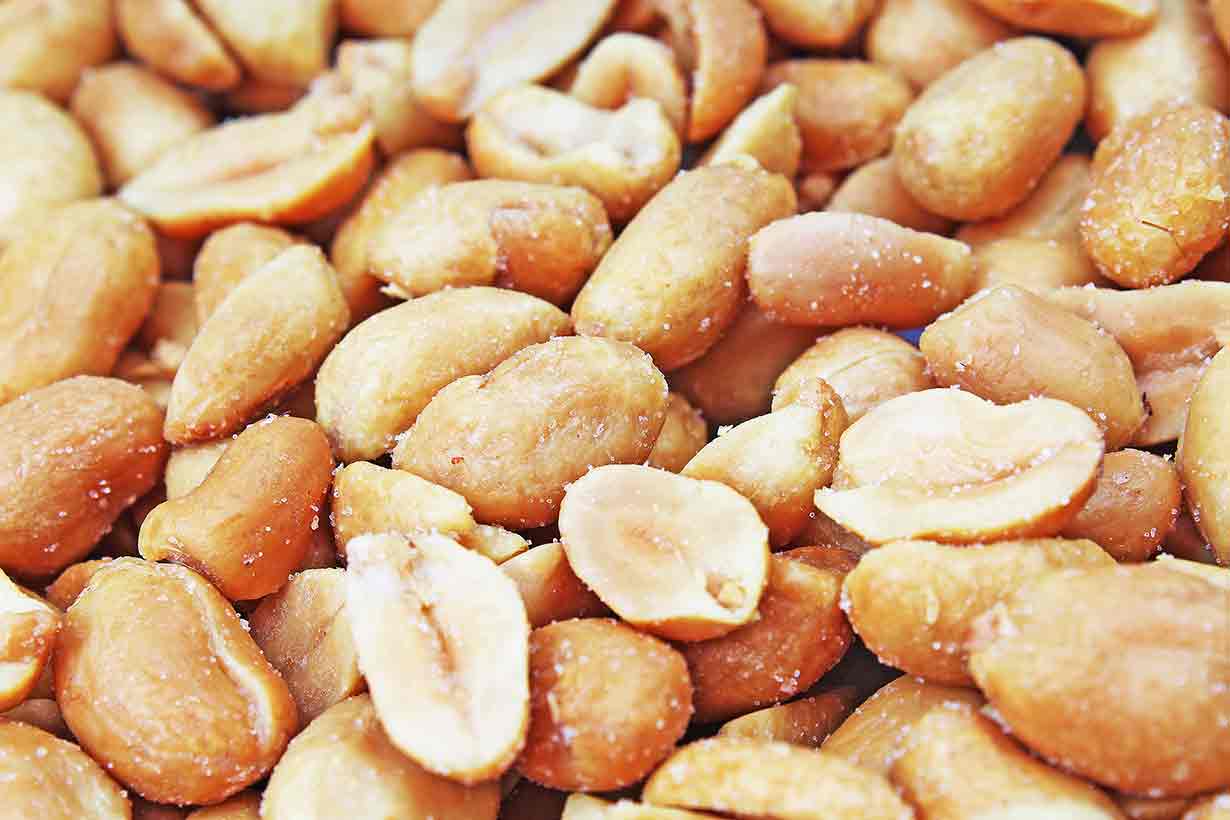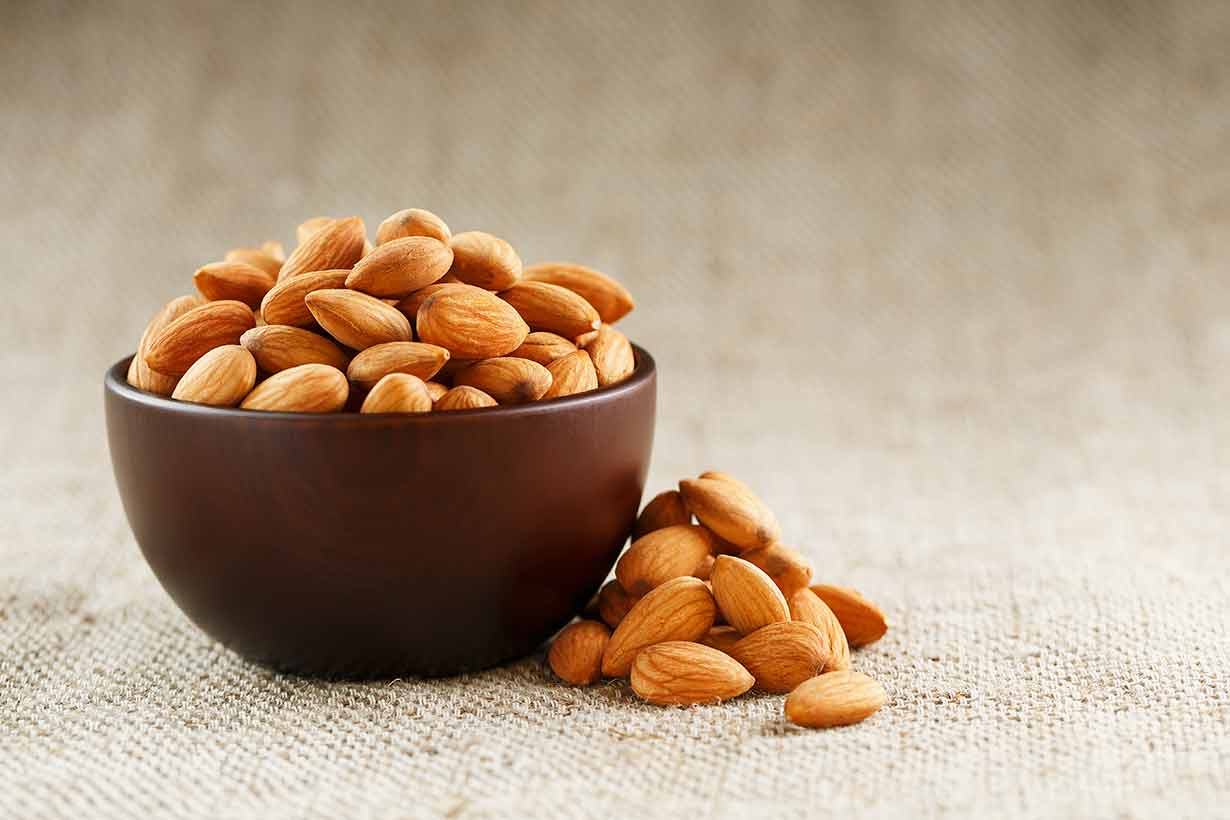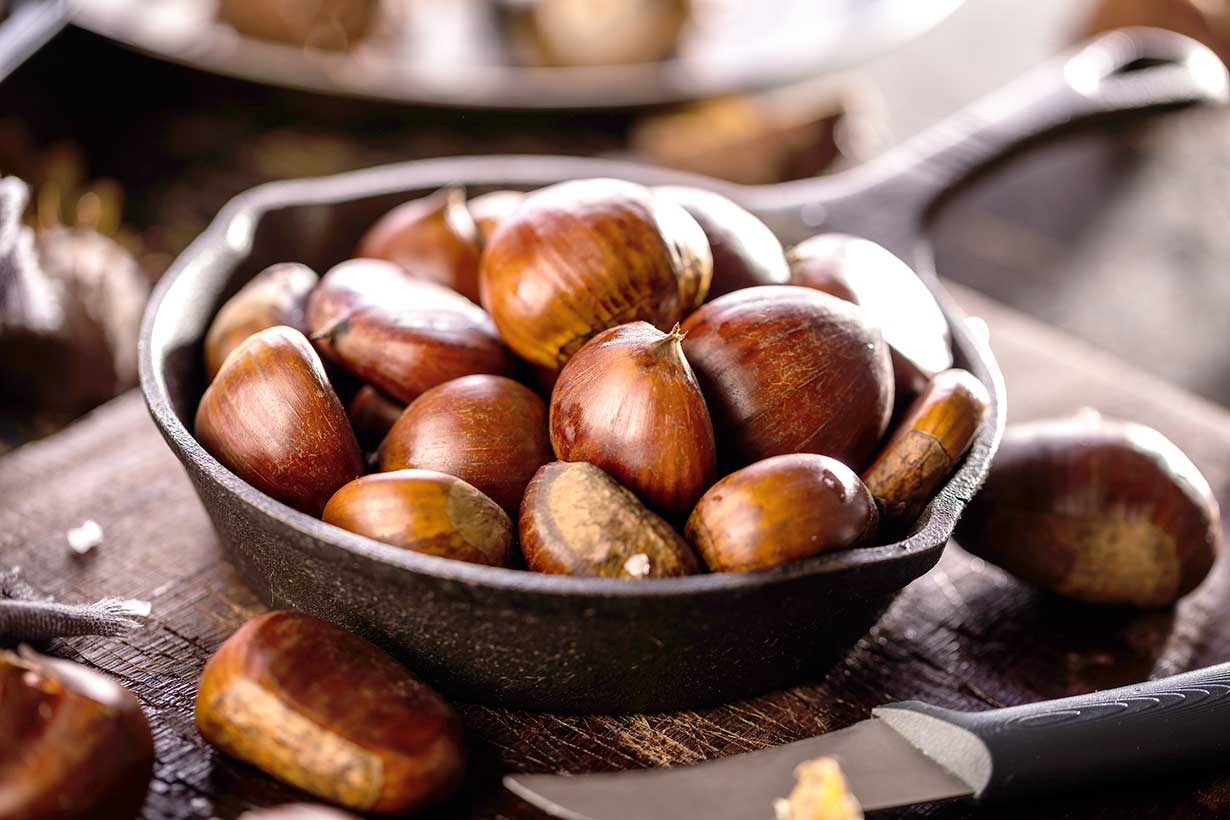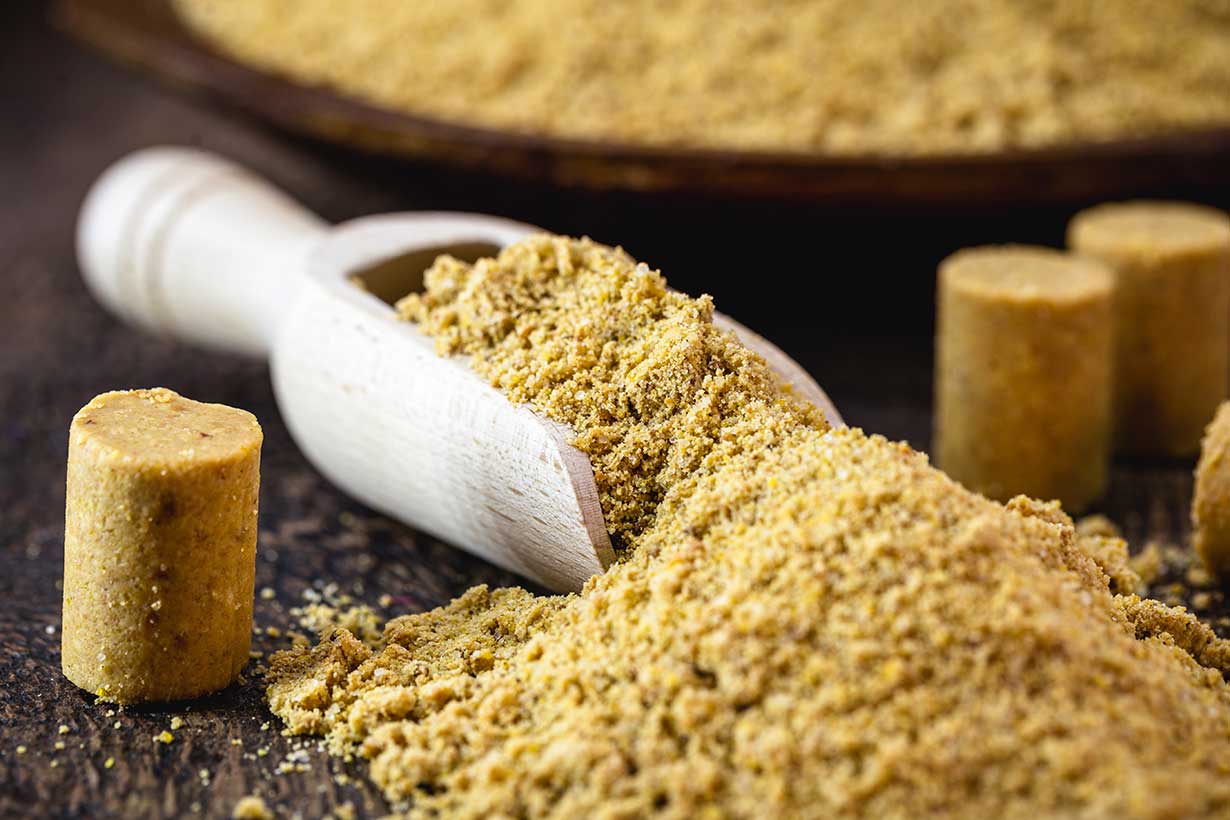Nuts are a diverse and nutritionally rich food group with numerous varieties to explore, each with its own set of unique nutritional benefits,
This article provides a guide to all the different types of nuts, featuring all the common nut varieties and some lesser-known options.
For each nut we’ll delve into each nut’s characteristics and nutritional data.
Unless otherwise stated, the source of all nutritional values is the USDA’s FoodData Central nutrition database.
Table of contents
- 1) Acorns
- 2) Almonds
- 3) Baru Nuts
- 4) Black Walnuts
- 5) Brazil Nuts
- 6) Cashew Nuts
- 7) Chestnuts
- 8) Gabon Nuts
- 9) Hazelnuts
- 10) Hickory Nuts
- 11) Macadamia
- 12) Marcona Almonds
- 13) Peanuts
- 14) Pecans
- 15) Pili Nuts
- 16) Pine Nuts
- 17) Pistachio
- 18) Sacha Inchi
- 19) Tiger Nuts
- 20) Walnuts (English Walnuts)
- How Do Nuts Compare Nutritionally?
- Incorporating Nuts Into Your Diet
- Are There Any Downsides To Eating Nuts?
- Frequently Asked Questions
- Final Thoughts
1) Acorns

Perhaps surprisingly to some, acorns can be an edible and nutritious nut.
Throughout history, acorns have served as a food source and were once a dietary staple worldwide. Interestingly, historical records show that acorns played a significant role in human diets as far back as 6000 BC (1).
However, acorns require special preparation methods, notably leaching, to reduce their naturally high tannin content (2).
In current times, perhaps owing to the lengthy preparation process, acorns have lost some of their former popularity as a food source.
That said, they still remain popular in certain cuisines. For example, in Korean cuisine, acorn jelly and acorn noodles are common foods.
An ounce (28.35 gram) serving of acorns provides (3):
- Calories: 110 kcal
- Carbohydrates: 11.6 g
- Fat: 6.78 g
- Saturated: 0.88 g
- Monounsaturated: 4.28 g
- Polyunsaturated: 1.3 g
- Omega-3: 0 g
- Omega-6: 1.3 g
- Protein: 1.74 g
Quick Facts
- Acorns are a true tree nut.
- An ounce (28g) serving of acorns is equivalent to approximately nine acorns.
- Acorns are not exceptionally high in vitamins or minerals, but they offer a moderate source of manganese: approximately 17% of the daily value (3, 4).
Find out more about acorns and their nutritional benefits here
2) Almonds

Almonds are tree nuts with roots in the Middle East and a history spanning thousands of years.
Beyond their appeal as whole nuts, almonds are the key ingredient in a range of food products. Some popular options include almond flour and almond milk.
Per ounce (28.35 gram) serving, unroasted almonds provide (5):
- Calories: 164 kcal
- Carbohydrates: 6.12 g
- Fiber: 3.54 g
- Sugars: 1.23 g
- Fat: 14.1 g
- Saturated: 1.08 g
- Monounsaturated: 8.96 g
- Polyunsaturated: 3.49 g
- Omega-3: 0.01 g
- Omega-6: 3.5 g
- Protein: 6.01 g
Quick Facts
- Almonds are a true tree nut.
- An ounce (28g) serving is equivalent to approximately twenty-three almonds.
- Almonds are also an excellent vitamin E and manganese source, offering 48% and 27% of the daily value, respectively (4, 5).
See this full guide to the nutritional properties of almonds for more information
For more on almond products, see this guide to almond flour.
3) Baru Nuts

Baru nuts, though relatively lesser-known, have seen a rise in popularity over recent years.
Similar to other foods we commonly label as “nuts,” baru nuts aren’t actually tree nuts. Instead, they belong to the legume family, much like peanuts (6).
Growing primarily in Brazil, these nuts offer a wide range of nutritional benefits, a visually striking appearance, and a delicious taste.
The USDA provides a comprehensive listing for baru nuts, detailing their nutritional values per 3-tbsp (30-gram) serving. However, to keep things consistent, the values have been calculated and adjusted for an ounce-sized serving (7):
- Calories: 151 kcal
- Carbohydrates: 8.5 g
- Fiber: 3.8 g
- Sugars: 0.9 g
- Fat: 11.3 g
- Saturated: 2.4 g
- Protein: 6.6 g
Quick Facts
- Botanically, baru nuts are legume seeds rather than tree nuts.
- Baru nuts are moderately high in all three macronutrients: carbohydrates, fat, and protein.
See this guide to baru nuts and their nutritional benefits for more information
4) Black Walnuts
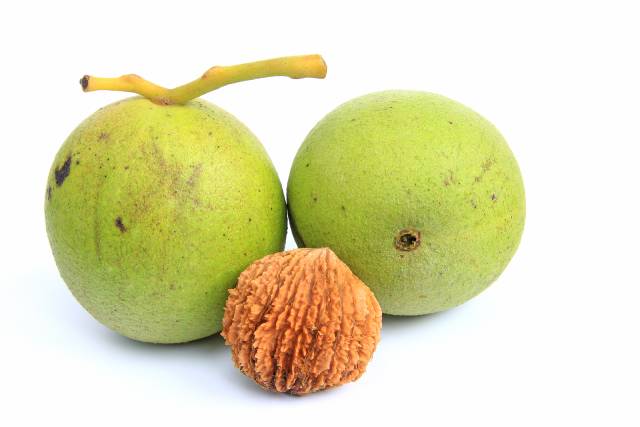
While many of us are familiar with the term ‘walnut,’ it’s worth noting that there are actually two common types of this nut.
The first is the English walnut, widely prevalent and scientifically known as ‘Juglans regia’ (8).
The second variety is the black walnut, with the scientific name ‘Juglans nigra’ (9).
Nutritionally, both types of walnuts offer similar benefits. However, English walnuts boast a milder and more pleasant taste, making them more readily available. As a result, the majority of walnut products use English walnuts as their primary ingredient.
Let’s take a look at the nutritional values for an ounce (28.35g) serving of black walnuts (10):
- Calories: 175 kcal
- Carbohydrates: 2.72 g
- Fiber: 1.93 g
- Sugars: 0.31 g
- Fat: 16.8 g
- Saturated: 0.99 g
- Monounsaturated: 4.37 g
- Polyunsaturated: 10.3 g
- Omega-3: 0.76 g
- Omega-6: 9.58 g
- Protein: 6.83 g
Quick Facts
- Black walnuts are a true tree nut.
- In comparison to regular (English) walnuts, black walnuts boast fewer calories, carbohydrates and fat, while offering over 50% more protein.
- Furthermore, black walnuts are rich in both manganese and copper, providing substantial amounts of these essential minerals.
Learn more: Black Walnuts: Nutritional Values and Benefits
5) Brazil Nuts

Brazil nuts grow in the vast Amazon rainforest in South America.
True to their name, these nuts are particularly prevalent in Brazil, as well as in neighboring countries like Bolivia, Colombia, and Venezuela.
The impressive Bertholletia excelsa, better known as the Brazil nut tree, is where these nuts grow, with the trees soaring to hundreds of meters in height (11).
Brazil nuts are the largest of all nut varieties, and they have a unique nutritional distinction; they contain more dietary selenium than any other food (12).
Appreciated in their whole form, these nuts also enjoy popularity when coated in chocolate.
Nutritionally, Brazil nuts offer the following nutrients per ounce (28.35-gram) serving (13):
- Calories: 187 kcal
- Carbohydrates: 3.32 g
- Fiber: 2.13 g
- Sugars: 0.66 g
- Fat: 19.0 g
- Saturated: 4.56 g
- Monounsaturated: 6.78 g
- Polyunsaturated: 6.92 g
- Omega-3: 0.01 g
- Omega-6: 6.78 g
- Protein: 4.05 g
Quick Facts
- Just one serving of Brazil nuts also provides 544 mcg of selenium, equivalent to 989% of the daily value (4, 13).
- An ounce (28.35g) serving of Brazil nuts is approximately 5-6 Brazil nuts.
See this full guide to Brazil nuts for more information
6) Cashew Nuts

Cashews, a genuine tree nut, have production centers primarily in Asia and Africa, with Vietnam and India being the top exporters (14).
In contrast to various other nuts, cashews boast a relatively higher concentration of carbohydrates, while their fat content is slightly lower.
Per ounce (28-gram) serving, they offer (15):
- Calories: 157 kcal
- Carbohydrates: 8.56 g
- Fiber: 0.94 g
- Sugars: 1.68 g
- Fat: 12.4 g
- Saturated: 2.21 g
- Monounsaturated: 6.75 g
- Polyunsaturated: 2.22 g
- Omega-3: 0.02 g
- Omega-6: 2.21 g
- Protein: 5.16 g
Quick Facts
- Cashews are a mineral-rich nut, providing generous amounts of copper, magnesium, and manganese.
- Curiously, cashew nuts differ from most nuts by growing outside the fruit rather than inside. This unique characteristic comes from the nuts being attached to the bottom of the cashew nut fruit.
- An ounce (28.35g) serving is roughly 18-20 cashew nuts.
See this guide for more on the nutritional benefits of cashews
7) Chestnuts

Chestnuts stand out among common kinds of nuts since they are primarily a source of starchy carbohydrates.
Five countries dominate worldwide chestnut production: China, Bolivia, Turkey, South Korea, and Italy (16).
These delectable nuts often make an appearance for sale in the winter, particularly in their delicious freshly-roasted form.
Per ounce (28.35g) serving, roasted chestnuts offer (17):
- Calories: 70 kcal
- Carbohydrates: 15.0 g
- Fiber: 1.45 g
- Sugars: 3.0 g
- Fat: 0.62 g
- Saturated: 0.12 g
- Monounsaturated: 0.22 g
- Polyunsaturated: 0.25 g
- Omega-3: 0.03 g
- Omega-6: 0.22 g
- Protein: 0.90 g
Quick Facts
- While chestnuts are categorized as a true tree nut, their nutritional profile sets them apart from other types of nuts. The key difference lies in their high carbohydrate and minimal fat content.
- An ounce (28.35g) is approximately 3-4 chestnuts.
For more information, here is a full nutritional guide to chestnuts
8) Gabon Nuts
Gabon nuts come from the Coula edulis tree, a species native to Western Africa. These nuts possess an approximate fat content of 50% by weight, primarily in the form of monounsaturated fatty acid oleic acid (18).
With a mild and nutty taste, Gabon nuts are often likened to hazelnuts, though they boast their own distinct flavor.
Referred to as African walnuts, Gabon nuts are not as commercially prevalent as more familiar nut varieties like almonds and peanuts. However, you might come across them in specialty stores or online markets.
Unfortunately, at this time, there is no reliable nutritional data available for Gabon nuts.
9) Hazelnuts

Turkey currently stands as the dominant global producer of hazelnuts, contributing more than two-thirds of the world’s supply (19).
As one of the most popular nut varieties, hazelnuts feature in a wide range of delicious food products.
Renowned for their pairings with chocolate and coffee, hazelnuts are a valued nut for their culinary applications.
Per ounce (28-gram) serving, they offer (20):
- Calories: 178 kcal
- Carbohydrates: 4.73 g
- Fiber: 2.75 g
- Sugars: 1.23 g
- Fat: 17.2 g
- Saturated: 1.26 g
- Monounsaturated: 13.0 g
- Polyunsaturated: 2.24 g
- Omega-3: 0.03 g
- Omega-6: 2.22 g
- Protein: 4.25 g
Quick Facts
- Hazelnuts are a true tree nut.
- The nuts are a rich source of many vital nutrients, boasting high levels of manganese, copper, and vitamin E.
- An ounce (28.35g) typically contains around 21 hazelnuts.
See this overview of the benefits of hazelnuts for further information.
10) Hickory Nuts

Hickory nuts grow on various Hickory tree species, sharing some common traits with pecans.
Compared to more common types of nuts, hickory nuts are not as readily available in stores. Since they can be more difficult to find in stores, some enthusiasts enjoy foraging for them (21).
With a combination of buttery and mildly sweet flavors, hickory nuts provide an enjoyable taste.
Based on data from the NCC Food and Nutrient Database, here are the nutrition facts for an ounce (28-gram) serving of hickory nuts (22):
- Calories: 186 kcal
- Carbohydrates: 5.17 g
- Fiber: 1.81 g
- Sugars: 1.48 g
- Fat: 18.25 g
- Saturated: 2.0 g
- Monounsaturated: 9.25 g
- Polyunsaturated: 6.20 g
- Omega-3: 0.30 g
- Omega-6: 5.85 g
- Protein: 3.61 g
Quick Facts
- Hickory nuts are true tree nuts.
- The nuts are a good source of copper, manganese, and thiamin (vitamin B1).
- An ounce (28.35g) provides roughly 9-10 hickory nuts.
See here for a full guide to hickory nuts
11) Macadamia

The roots of macadamia nuts lie in Australia, where substantial commercial production also takes place.
However, it’s worth noting that South Africa dominates global production, accounting for a staggering 70,139 tons of macadamia nuts in 2022 (23).
With a delicious buttery taste and a high fat content, macadamia nuts are often a favorite.
On the downside, it’s important to note that they can be relatively pricey. Furthermore, compared to other nuts, they may contain lower amounts of vitamins and minerals.
A typical ounce (28.35-gram) serving offers (24):
- Calories: 204 kcal
- Carbohydrates: 3.91 g
- Fiber: 2.44 g
- Sugars: 1.30 g
- Fat: 21.5 g
- Saturated: 3.43 g
- Monounsaturated: 16.7 g
- Polyunsaturated: 0.43 g
- Omega-3: 0.06 g
- Omega-6: 0.37 g
- Protein: 2.24 g
Quick Facts
- Macadamias are tree nuts.
- Among the vitamins and minerals they provide, macadamias provide a notable concentration of manganese and thiamin (vitamin B1).
- An ounce (28.35g) provides approximately 10-12 macadamia nuts.
See this guide to the nutritional benefits of macadamia nuts for more information
12) Marcona Almonds
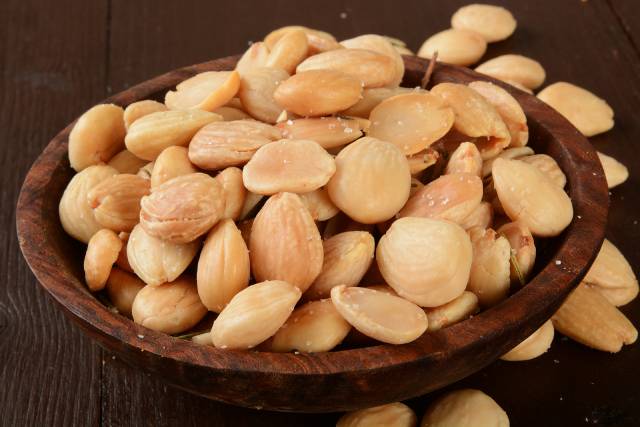
Marcona almonds, also referred to as ‘sweet almonds,’ are native to Spain, and they offer distinct characteristics.
With a larger size, higher fat content, and a buttery texture, Marcona almonds present some significant differences from regular almonds.
As shown in the picture above, Marcona almonds look somewhat like a fusion of regular almonds and macadamia nuts.
An ounce (28.35-gram) serving of Marcona almonds has the following nutritional values (25):
- Calories: 170 kcal
- Carbohydrates: 5.01 g
- Fiber: 3.0 g
- Sugars: 1.0 g
- Fat: 15.0 g
- Saturated: 1.0 g
- Protein: 5.99 g
Quick Facts
- Marcona almonds often carry a higher price tag compared to regular almonds, due to their importation.
- Marcona almonds provide a delightful creamier and mildly sweeter taste than regular almonds. However, they share many similarities nutritionally speaking. There are some slight differences, though, such as marginally lower carbohydrate and slightly higher fat levels.
13) Peanuts

Though technically classed as a legume, peanuts have a secure place as one of the most popular types of ‘nuts.’
One of their most famous applications is peanut butter, which is also the most popular of the different nut butters.
Whether salted, dry-roasted, or transformed into peanut butter, peanuts never fail to satisfy consumer tastes.
The immense popularity of peanuts reflects in global production, which stands at approximately 45 million tons per year. Interestingly, China produces more than double the peanuts of any other country (26).
Despite being a legume botanically, peanuts share many of the same nutritional characteristics as true tree nuts, including their notably high fat content.
Here are the basic nutritional values per ounce (28.35g) serving of peanuts (27):
- Calories: 161 kcal
- Carbohydrates: 4.56 g
- Fiber: 2.41 g
- Sugars: 1.34 g
- Fat: 13.9 g
- Saturated: 1.78 g
- Monounsaturated: 6.92 g
- Polyunsaturated: 4.42 g
- Omega-3: 0.001 g
- Omega-6: 4.42 g
- Protein: 7.31 g
Quick Facts
- Although peanuts are sold and used as nuts, they are botanically not true tree nuts. Instead, they belong to the legume family.
- An ounce (28.35g) serving is approximately 30-35 peanuts.
- Peanuts are arguably the most popular common nut.
See this in-depth guide to peanuts for more information
Learn more about other peanut products:
A guide to peanut butter powder
14) Pecans

Pecans enjoy widespread popularity for their versatility in baking, but they are also valued for their taste on their own.
The United States leads the world in pecan production, turning out more than 250 million pounds of these nuts per year (28).
Nutritionally, pecans offer a good profile, with the following values present in a oune-ounce (28.35g) serving (29):
- Calories: 196 kcal
- Carbohydrates: 3.94 g
- Fiber: 2.72 g
- Sugars: 1.12 g
- Fat: 20.4 g
- Saturated: 1.75 g
- Monounsaturated: 11.6 g
- Polyunsaturated: 6.12 g
- Omega-3: 0.28 g
- Omega-6: 5.84 g
- Protein: 2.60 g
Quick Facts
- Pecans are a true tree nut.
- Among the nutrients they contain, pecans are a rich source of manganese and copper.
- An ounce (28.35g) serving is equivalent to approximately 19 pecan halves.
- Pecans are one of the most popular nuts used in desserts, and they feature in a variety of cakes and pastries.
See here for a full guide to pecans and their benefits
15) Pili Nuts

Pili nuts primarily grow in Northern Australia and the Philippines, with the latter responsible for producing over 80% of the global supply (30).
In recent years, pili nuts have witnessed a surge in popularity, gradually becoming more readily available worldwide.
The nuts boast a higher fat content per gram per gram than any other nut, which contributes to their delicious and mild taste.
Per ounce (28-gram) serving, pili nuts offer the following nutrients (31):
- Calories: 204 kcal
- Carbohydrates: 1.13 g
- Fat: 22.6 g
- Saturated: 8.84 g
- Monounsaturated: 10.5 g
- Polyunsaturated: 2.16 g
- Protein: 3.06 g
Quick Facts
- Pili nuts are true tree nuts.
- Pili nuts are not among the most vitamin and mineral-rich nut choices. However, they offer moderately high amounts of manganese, magnesium thiamin, phosphorus, and copper.
- An ounce (28.35g) serving is roughly 15 pili nuts.
For more information, see this full guide to the unique pili nut
16) Pine Nuts

Pine nuts are one of the harder-to-find nut varieties, but they taste delicious. Notably, they are one of the key ingredients in the famous condiment, pesto.
In recent times, pine nuts have become more visible, and they offer an excellent nutritional profile.
For a one-ounce (28.35g) serving, pine nuts offer the following nutritional values (32):
- Calories: 191 kcal
- Carbohydrates: 3.71 g
- Fiber: 1.05 g
- Sugars: 1.02 g
- Fat: 19.4 g
- Saturated: 1.39 g
- Monounsaturated: 5.33 g
- Polyunsaturated: 9.67 g
- Omega-3: 0.046 g
- Omega-6: 9.41 g
- Protein: 3.88 g
Quick Facts
- Pine nuts provide a great source of manganese, copper, and magnesium.
- An ounce (28.35g) serving equals approximately 167 pine nut kernels.
- Pine nuts are true tree nuts.
See this complete guide to pine nuts for further information
17) Pistachio

Unlike most other types of nuts, pistachios are typically sold in their shells.
Originating from the Middle East, the primary producers of pistachios are now Iran and the United States (33).
With a pleasant, mild, and slightly sweet taste, pistachios become even tastier when paired with a pinch of salt. In this context, the added advantage of having to crack open each shell is that it helps to stop people overindulging!
Per standard ounce (28.35g) serving, pistachios provide (34):
- Calories: 159 kcal
- Carbohydrates: 7.71 g
- Fiber: 3.0 g
- Sugars: 2.17 g
- Fat: 12.8 g
- Saturated: 1.68 g
- Monounsaturated: 6.61 g
- Polyunsaturated: 4.08 g
- Omega-3: 0.08 g
- Omega-6: 4.0 g
- Protein: 5.73 g
Quick Facts
- Pistachios are also a good source of copper, vitamin B6, and thiamin (B1).
- An ounce (28.35g) serving is equivalent to 49 pistachio nut kernels.
- The pistachio is a tree nut.
See this full guide to the nutritional benefits of pistachio nuts for more information
18) Sacha Inchi

Like almonds, sacha inchi are seeds, not true nuts, yet they are sold and marketed as nuts.
These nuts are also known as ‘Inca peanuts.’
A significant amount of sacha inchi production takes place in the Amazon rainforest, with leading producers including Colombia, Ecuador, and Peru (35).
However, due to their importation from distant locations, sacha inchi nuts can be relatively expensive.
Per ounce (28.35-gram) serving, sacha inchi nuts provide the following nutritional values (36):
- Calories: 170 kcal
- Carbohydrates: 5.0 g
- Fiber: 5.0 g
- Fat: 13.0 g
- Saturated: 1.0 g
- Monounsaturated: 1.0 g
- Polyunsaturated: 11.0 g
- Protein: 9.0 g
Quick Facts
- As indicated in the nutritional values above, sacha inchi nuts are a surprisingly rich source of protein, providing nine grams per ounce.
- Sacha inchi ‘nuts’ are not genuine tree nuts, and they are botanically classified as seeds.
- Furthermore, sacha inchi nuts are a notable plant-based source of omega-3. Approximately half of their polyunsaturated fat content comprises alpha-linolenic acid, the form of omega-3 found in plant foods (37, 38).
This complete guide to sacha inchi nuts provides more information
19) Tiger Nuts

Despite containing the word “nuts” in their name and often being found in the ‘nuts’ section, tiger nuts aren’t technically nuts.
Although they boast a relatively high dietary fat content, tiger nuts are small tubers that share a closer botanical connection with foods like sweet potatoes (39).
However, much like traditional nuts, people enjoy tiger nuts in similar, varying ways.
They can be enjoyed alone, added to yogurt, tossed into trail mixes, and tiger nut flour is a popular baking option.
Based on research into the nutritional quality of tiger nuts, a standard ounce (28.35g) serving offers the following nutritional values (40, 41):
- Calories: 117 kcal
- Carbohydrates: 12.3 g
- Fiber: 2.5 g
- Sugars: 3.7 g
- Fat: 7.1 g
- Saturated: 1.2 g
- Monounsaturated: 5.1 g
- Polyunsaturated fat: 0.7 g
- Omega-3: <0.1 g
- Omega-6: 0.6 g
- Protein: 1.4 g
Quick Facts
- Tiger nuts are a good source of numerous vitamins and minerals, particularly manganese and thiamin (vitamin B1).
- Tiger nuts are tubers rather than true tree nuts.
- There are approximately 40 tiger nuts in an ounce (28.35g) serving.
See this guide to tiger nut’s nutritional values and potential benefits for more information
20) Walnuts (English Walnuts)

Walnuts rank high among the most popular types of nuts, with approximately 50% of global production originating from China (42).
Beyond being a favorite snack, they hold a prominent place as a significant ingredient in a diverse range of recipes.
Per ounce (28.35-gram) serving, the basic nutritional values of walnuts are as below (43):
- Calories: 183 kcal
- Carbohydrates: 3.88 g
- Fiber: 1.9 g
- Sugars: 0.74 g
- Fat: 18.5 g
- Saturated: 1.74 g
- Monounsaturated: 2.53 g
- Polyunsaturated fat: 13.4 g
- Omega-3: 2.57 g
- Omega-6: 10.8 g
- Protein: 4.31 g
Quick Facts
- The essential nutrients that walnuts provide in the highest amounts include copper, magnesium, and manganese.
- In each ounce (28.35g) serving, you can expect approximately 14 walnut halves.
- Walnuts are a true tree nut.
See this complete guide to walnuts for more information
How Do Nuts Compare Nutritionally?
Here is a table that compares the basic nutritional details of every nut featured in this guide for quick reference:
| Nut name | Calories | Carbs | Fat | Protein | Omega-3 | Omega-6 |
|---|---|---|---|---|---|---|
| Acorns | 110 | 11.6g | 6.8g | 1.7g | 0g | 1.3g |
| Almonds | 164 | 6.12g | 14.1g | 6.01g | 0.01g | 3.5g |
| Baru nuts | 155 | 8.5g | 11.3g | 6.6g | – | – |
| Black walnuts | 175 | 2.72g | 16.8g | 6.83g | 0.76g | 9.58g |
| Brazil nuts | 187 | 3.32g | 19.0g | 4.05g | 0.01g | 6.78g |
| Cashew nuts | 157 | 8.56g | 12.4g | 5.16g | 0.02g | 2.21g |
| Chestnuts | 70 | 15.0g | 0.62g | 0.90g | 0.03g | 0.22g |
| Hazelnuts | 178 | 4.73g | 17.2g | 4.25g | 0.03g | 2.22g |
| Hickory nuts | 186 | 5.17g | 18.25g | 3.61g | 0.30g | 5.85g |
| Macadamia nuts | 204 | 3.91g | 21.5g | 2.24g | 0.06g | 0.37g |
| Marcona almonds | 170 | 5.01g | 15.0g | 5.99g | – | – |
| Peanuts | 161 | 4.56g | 13.9g | 7.31g | 0.001g | 4.42g |
| Pecans | 196 | 3.94g | 20.4g | 2.60g | 0.28g | 5.84g |
| Pili nuts | 204 | 1.13g | 22.6g | 3.06g | – | – |
| Pine nuts | 191 | 3.71g | 19.4g | 3.88g | 0.046g | 9.41g |
| Pistachio | 159 | 7.71g | 12.8g | 5.73g | 0.08g | 4.0g |
| Sacha inchi nuts | 170 | 5.0g | 13.0g | 9.0g | – | – |
| Tiger nuts | 117 | 12.3g | 7.1g | 1.4g | 0.1g | 0.6g |
| Walnuts (English) | 185 | 3.88g | 18.5g | 4.31g | 2.57g | 10.8g |
(Note: the nutritional values were unavailable for omega-3 and omega-6 in table cells featuring a dash).
Incorporating Nuts Into Your Diet
When attempting to incorporate more nuts into our diet, there are some essential factors to keep in mind.
These considerations encompass portion control, ways to add nuts to the diet, and selecting nuts that align with specific dietary preferences.
Portion Control
While nuts are a healthy choice, it’s vital to be mindful of their energy density since they can be easy to over-consume.
In this regard, be cautious of sitting with a bag of salted nuts in front of you, as it can easily lead to consuming multiple servings instead of just one.
To encourage sensible nut consumption, consider these ideas:
- A standard serving of nuts is typically one ounce (28.35g) or 30 grams, roughly equivalent to a small to medium handful.
- To accurately measure the portion, use kitchen scales, as it’s easy to underestimate the weight of nuts on a plate.
- If kitchen scales aren’t available, a medium ‘handful’ should be approximately 30 grams (44).
- Incorporate nuts into a meal, as it will be more filling than consuming nuts alone. For example, pair them with a piece of fruit and a slice of cheese or add them to porridge or yogurt.
The Best Nuts For Specific Dietary Considerations
Here are some suggestions tailored for popular diets and specific dietary preferences:
- Ketogenic diets: the ideal choices are macadamia, pili, and pine nuts, as they are the lowest in carbohydrates and highest in fat.
- High-protein: almonds, baru nuts, black walnuts, peanuts, and sacha inchi nuts lead the way as the highest-protein choices.
- High-carbohydrate, low-fat: acorns, chestnuts, and tiger nuts are the best fit.
Recipe Ideas
Here is a list of simple ways to incorporate more nuts into your diet:
- Swap existing ‘snacks’ with a handful of nuts.
- Sprinkle nuts onto your breakfast cereal or porridge.
- Mix some nuts into a serving of yogurt.
- Create a trail mix by combining nuts, dried fruit, seeds, and dark chocolate pieces.
- Blend some nuts into smoothies for a nutrient boost.
Regarding the first idea, studies have indicated that replacing snacks like potato chips with nuts can yield several benefits. Randomized controlled trials have demonstrated that incorporating nuts into the diet as a replacement for common snacks (e.g. pretzels) can (42, 43, 44):
- Enhance satiety levels, leaving people more satisfied after eating and reducing hunger.
- Potentially contribute to weight loss goals.
- Improve markers of cardiovascular health.
Or Make Homemade Nut Flours
Another potential way to incorporate more nuts into your diet is by using nut flours as a substitute for white flour.
Popular options like almond flour add an enjoyable taste to food yet also provide a boost of nutrients.
Interestingly, making nut flours at home is a straightforward process; all you need are your nuts of choice and a high-quality blender.
It is important not to blend the nuts for too long when attempting to make nut flour at home. Overblending can lead to the release of the fat content in the nuts, resulting i a sticky
Generally, it only takes about 10 seconds of blending to achieve the right texture. However, this can vary depending on the specific nuts and quantity used, so use your judgment accordingly.
Are There Any Downsides To Eating Nuts?
In general, nuts are nutritious and provide protein, healthy fats, and an array of essential vitamins and minerals.
Further, they offer a budget-friendly and accessible food option.
However, like anything else, there may be some potential downsides to consider.
Allergies
On the downside, nut allergies are relatively common, and allergic reactions to nuts can sometimes be severe (42, 43).
For further information on nut allergies, these valuable guides are available:
- ‘Tree Nut Allergy’ by Food Allergy Research and Education (FARE)
- ‘Everything You Need To Know About Tree Nut Allergy’ by the American Academy of Allergy Asthma and Immunology
Some Packaged Nuts Are Quite Salty
Additionally, it’s worth noting that some packaged nuts come pre-salted.
While there’s nothing wrong with eating salted nuts for those who enjoy the taste, individuals being mindful of their salt intake should be aware of this.
Frequently Asked Questions
If this guide hasn’t addressed all potential questions, below are the answers to some common questions people have about nuts.
Nuts can be a valuable source of protein, but it varies depending on the specific nut. While some options, like almonds and peanuts, offer a decent amount of protein, others such as acorns, chestnuts, macadamia nuts, and tiger nuts, contain lower protein. It’s also worth noting that nuts are not as high in protein per calorie compared to protein-rich alternatives like meat, fish, beans, lentils, tofu, milk, and cheese.
Yes, nuts are considered whole foods. On the other hand, nut products like almond flour and peanut butter are processed foods. However, it’s important to note that not all ‘processed’ foods are inherently bad; many can be excellent sources of nutrients.
Whether nuts contribute to weight loss or not largely depends on two critical questions: “compared to what?” and “in what amount?” In simpler terms, nuts are a healthier alternative to ultra-processed snacks, but incorporating additional nuts into a diet with existing excessive food intake won’t be beneficial. However, nuts may support weight loss when integrated into a well-balanced overall diet.
Almonds, baru nuts, black walnuts, Marcona almonds, peanuts, and sacha inchi are the most protein-rich nut options. These nuts have between 6 grams and 9 grams of protein per ounce (28.35g) serving.
Almonds, baru nuts, cashew nuts, and chestnuts contain moderately high carbohydrates. These nuts provide from 6 grams to 15 grams of carbohydrate per ounce (28.35g) serving.
Brazil nuts, pecans, pine nuts, pili nuts, and walnuts have the highest fat content. These nuts contain between 18.5g and 22.6g of fat per ounce (28.35g) serving.
Some nuts can be quite expensive. Buying nuts in bulk provides greater value for money for those who can. All nuts contain beneficial nutrients, so choosing whichever nuts are best-priced at the point of purchase can also help to reduce costs.
Nuts are naturally free of gluten, which is good news for those with gluten sensitivities. However, it is essential to be aware that some types of nuts are available in ‘flavored’ or seasoned varieties. These seasonings may sometimes include ingredients that contain gluten, so it is crucial to check the labels of such products carefully.
To maintain the freshness of nuts, it is generally better to purchase them in smaller quantities, ensuring they are consumed while still fresh. However, there are several steps that you can take to preserve the freshness of already opened nuts.
These steps include storing the nuts in a cool, dry, and dark place, ideally in airtight containers. Additionally, nuts should keep for even longer if stored in a refrigerator. The label of the nut product should also provide guidance on the recommended storage time. A quick smell and taste test should also help to determine how fresh the nuts are.
Final Thoughts
As demonstrated in this guide, there are many types of nuts, each boasting their own unique properties and nutritional characteristics.
When incorporated into a healthy and well-balanced dietary pattern, nuts provide a wide range of nutritional benefits.

